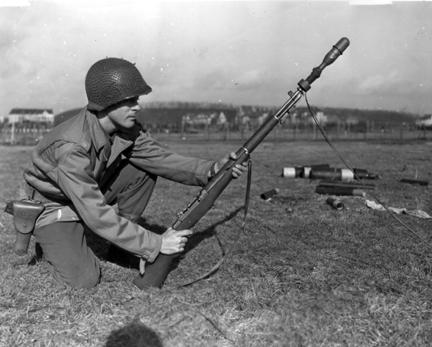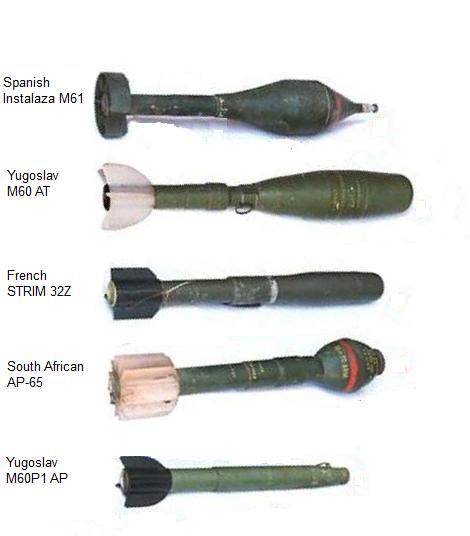|
M52 Rifle Grenade
The Modèle 1952 34mm HE rifle grenade was in French service from 1952 to 1978. It was used alongside the APAV40 rifle grenade in French service. It was propelled by being mounted atop a rifle's 22 mm grenade launching adapter, and being launched by a ballistite (blank) cartridge. In common with other rifle grenades of this era, they became obsolescent when the bullet trap form of propulsion became popular at the end of the 1970s. The Yugoslavian M60 anti-personnel grenade, similarly launched from a rifle's 22 mm grenade A 22 mm rifle grenade is inserted over the firing mechanism on the front of rifles that are equipped with the appropriate spigot-type launcher, either in the form of an integral flash suppressor or a detachable adapter. As with most rifle ... launching adapter by a ballistite cartridge, bears a strong resemblance. Sources and referencesFrench army manual on rifle grenades dated 1966 with an illustration of the Modèle 1952 and text on pages 21 to 22 E ... [...More Info...] [...Related Items...] OR: [Wikipedia] [Google] [Baidu] |
APAV40
The APAV 40 (''anti-personnel/anti-véhicule'', 40mm) is a 40 mm dual purpose rifle grenade used by the French Army. Design The APAV 40 is a dual purpose, anti-personnel (AP) and anti-vehicle (AV), 40 mm rifle-grenade. It has a mass of 405 grams, and a tail with stabilizing fins. Explosion is triggered by an impact fuse. Two versions of the APAV 40 exist: * the older F1 model which must be fired with a blank cartridge * the current F2 model which uses a bullet-trap that allows using live rounds Use To launch, the APAV40 F2 is placed over the muzzle of a FAMAS or any NATO rifle with a (22 mm) STANAG muzzle device. Then the rifle is aimed at the target and fired. The impact of the bullet striking the bullet-trap and the expanding gases launch and arm the grenade, which explodes on impact. In its antipersonnel capacity, the APAV 40 is used in indirect fire. The APAV 40 has a lethal radius of 12 metres and its shrapnel is dangerous up to 100 metres away. In its anti ... [...More Info...] [...Related Items...] OR: [Wikipedia] [Google] [Baidu] |
22 Mm Grenade
A 22 mm rifle grenade is inserted over the firing mechanism on the front of rifles that are equipped with the appropriate spigot-type launcher, either in the form of an integral flash suppressor or a detachable adapter. As with most rifle grenades, it is propelled by a blank cartridge inserted into the chamber of the rifle. A 22 mm grenade can range from a powerful anti-tank round to a simple finned tube with a fragmentation hand grenade attached to the end. The "22 mm" refers to the diameter of the base tube which fits over the spigot of the launcher, not the diameter of the warhead section, which is much wider. This measurement practice differs from conventional launched grenades, such as the US 40 mm grenade, which are measured at their widest point, since they are launched out of gun-like barrels. Thus, a 22 mm rifle grenade can easily be as powerful as a 40 mm grenade, in spite of the seemingly smaller size. A 22 mm grenade is launched on the spi ... [...More Info...] [...Related Items...] OR: [Wikipedia] [Google] [Baidu] |
M60 Rifle Grenades
Yugoslavia manufactured two types of rifle grenade, both with the nomenclature of M60. The M60 anti-personnel rifle grenade bore a resemblance to the French M52 rifle grenade The Modèle 1952 34mm HE rifle grenade was in French service from 1952 to 1978. It was used alongside the APAV40 rifle grenade in French service. It was propelled by being mounted atop a rifle's 22 mm grenade launching adapter, and being launched b .... The M60 anti-tank rifle grenade bore a resemblance to the STRIM 65, also of French origin. It could penetrate 200mm of armour. Each was propelled by being mounted atop a rifle's 22 mm grenade launching adapter, and being launched by a ballistite (blank) cartridge. Sources and references External linksA crate of Yugoslavian anti-personnel rifle grenades captured from SWAPO in March 1982 [...More Info...] [...Related Items...] OR: [Wikipedia] [Google] [Baidu] |
Rifle Grenade
A rifle grenade is a grenade that uses a rifle-based launcher to permit a longer effective range than would be possible if the grenade were thrown by hand. The practice of projecting grenades with rifle-mounted launchers was first widely used during World War I and World War II and continues to the present, with the term "rifle grenade" now encompassing many different types of payloads including high explosive, fragmentation, anti-tank warheads, concussion, smoke, incendiary, and flare missiles. Rifle grenades have largely been supplanted in the infantry fire support role by a combination of grenade launchers (typically affixed to rifles) and disposable anti-armor rockets. History Early use Adaptation of grenades for use in rifles began around the 18th century, when cup-shaped dischargers were fitted to the barrels of flintlock muskets, with the grenades propelled by the force of a blank cartridge. During the early 20th century a Japanese Colonel Amazawa experimented ... [...More Info...] [...Related Items...] OR: [Wikipedia] [Google] [Baidu] |
French Army
The French Army, officially known as the Land Army (french: Armée de Terre, ), is the land-based and largest component of the French Armed Forces. It is responsible to the Government of France, along with the other components of the Armed Forces. The current Chief of Staff of the French Army (CEMAT) is General , a direct subordinate of the Chief of the Defence Staff (CEMA). General Schill is also responsible to the Ministry of the Armed Forces for organization, preparation, use of forces, as well as planning and programming, equipment and Army future acquisitions. For active service, Army units are placed under the authority of the Chief of the Defence Staff (CEMA), who is responsible to the President of France for planning for, and use of forces. All French soldiers are considered professionals, following the suspension of French military conscription, voted in parliament in 1997 and made effective in 2001. , the French Army employed 118,600 personnel (including the Fo ... [...More Info...] [...Related Items...] OR: [Wikipedia] [Google] [Baidu] |
Cold War Weapons Of France
Cold is the presence of low temperature, especially in the atmosphere. In common usage, cold is often a subjective perception. A lower bound to temperature is absolute zero, defined as 0.00K on the Kelvin scale, an absolute thermodynamic temperature scale. This corresponds to on the Celsius scale, on the Fahrenheit scale, and on the Rankine scale. Since temperature relates to the thermal energy held by an object or a sample of matter, which is the kinetic energy of the random motion of the particle constituents of matter, an object will have less thermal energy when it is colder and more when it is hotter. If it were possible to cool a system to absolute zero, all motion of the particles in a sample of matter would cease and they would be at complete rest in the classical sense. The object could be described as having zero thermal energy. Microscopically in the description of quantum mechanics, however, matter still has zero-point energy even at absolute zero, because ... [...More Info...] [...Related Items...] OR: [Wikipedia] [Google] [Baidu] |
Rifle Grenades
A rifle grenade is a grenade that uses a rifle-based launcher to permit a longer effective range than would be possible if the grenade were thrown by hand. The practice of projecting grenades with rifle-mounted launchers was first widely used during World War I and World War II and continues to the present, with the term "rifle grenade" now encompassing many different types of payloads including high explosive, fragmentation, anti-tank warheads, concussion, smoke, incendiary, and flare missiles. Rifle grenades have largely been supplanted in the infantry fire support role by a combination of grenade launchers (typically affixed to rifles) and disposable anti-armor rockets. History Early use Adaptation of grenades for use in rifles began around the 18th century, when cup-shaped dischargers were fitted to the barrels of flintlock muskets, with the grenades propelled by the force of a blank cartridge. During the early 20th century a Japanese Colonel Amazawa experimented ... [...More Info...] [...Related Items...] OR: [Wikipedia] [Google] [Baidu] |





